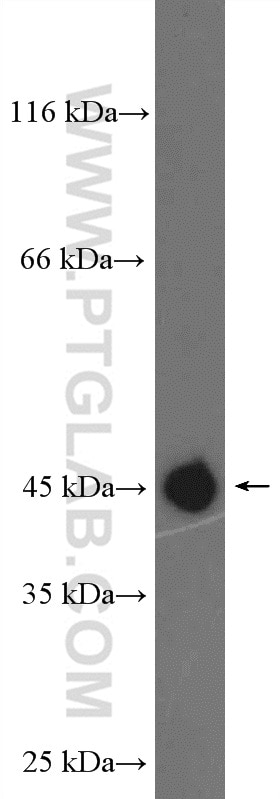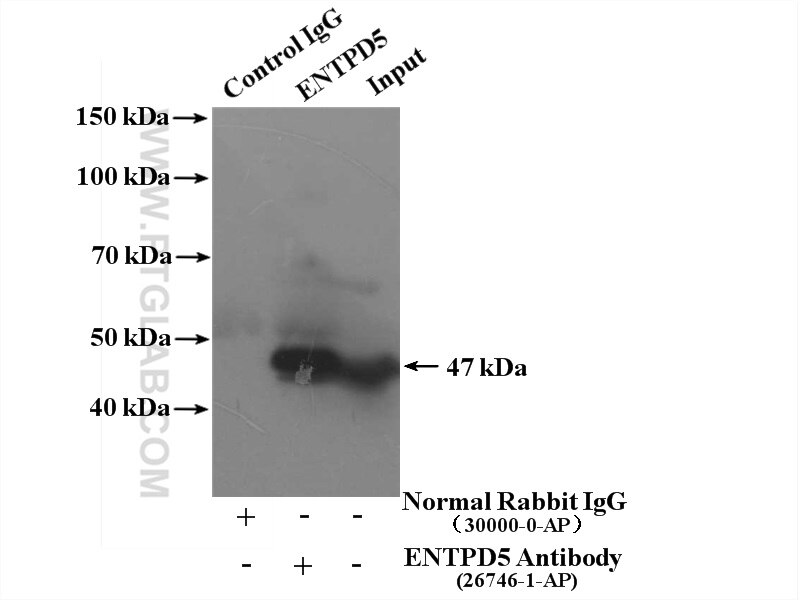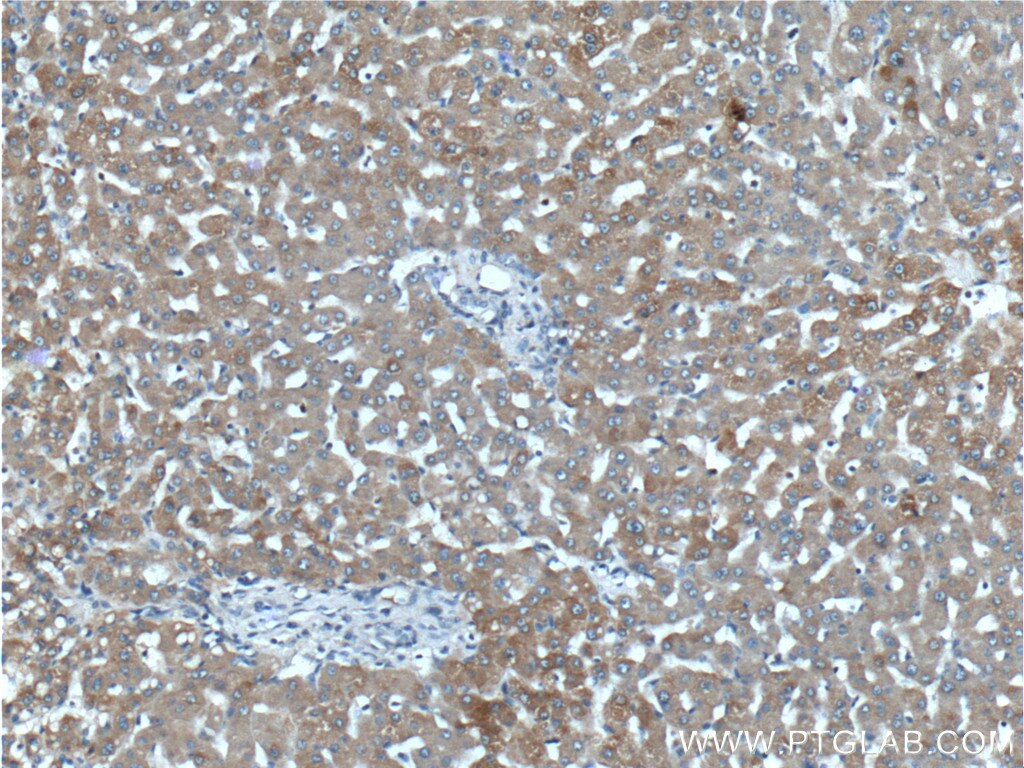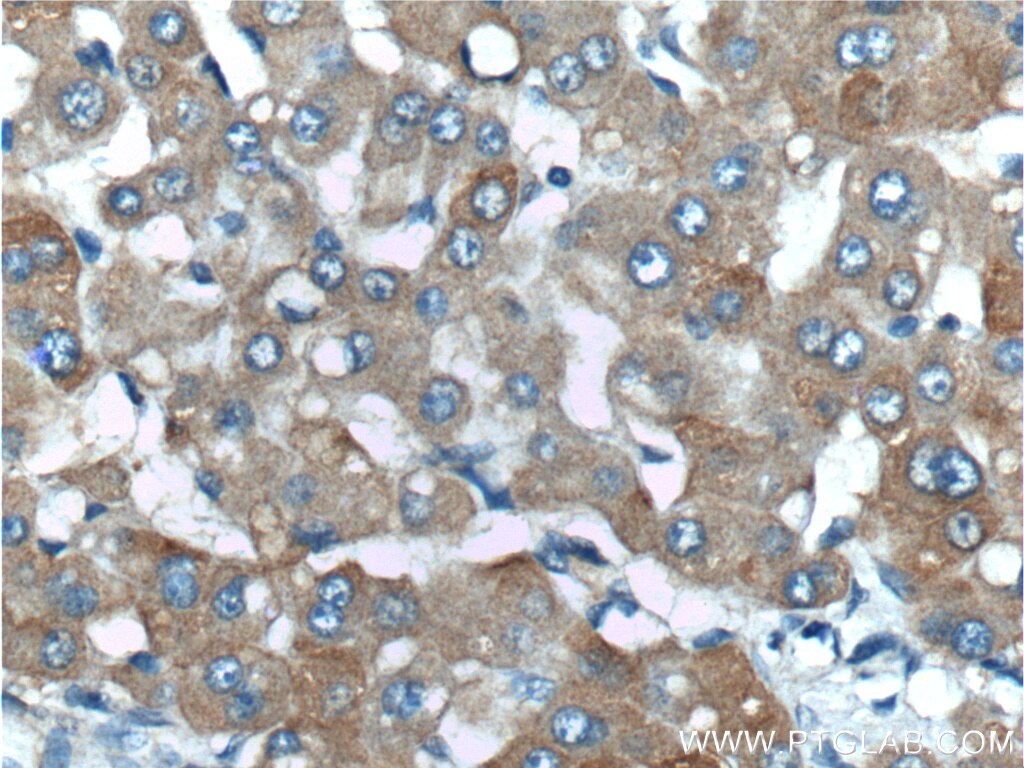Anticorps Polyclonal de lapin anti-ENTPD5
ENTPD5 Polyclonal Antibody for WB, IHC, IP, ELISA
Hôte / Isotype
Lapin / IgG
Réactivité testée
Humain, souris
Applications
WB, IHC, IP, ELISA
Conjugaison
Non conjugué
N° de cat : 26746-1-AP
Synonymes
Galerie de données de validation
Applications testées
| Résultats positifs en WB | tissu hépatique de souris |
| Résultats positifs en IP | tissu hépatique de souris |
| Résultats positifs en IHC | tissu hépatique humain il est suggéré de démasquer l'antigène avec un tampon de TE buffer pH 9.0; (*) À défaut, 'le démasquage de l'antigène peut être 'effectué avec un tampon citrate pH 6,0. |
Dilution recommandée
| Application | Dilution |
|---|---|
| Western Blot (WB) | WB : 1:500-1:2000 |
| Immunoprécipitation (IP) | IP : 0.5-4.0 ug for 1.0-3.0 mg of total protein lysate |
| Immunohistochimie (IHC) | IHC : 1:50-1:500 |
| It is recommended that this reagent should be titrated in each testing system to obtain optimal results. | |
| Sample-dependent, check data in validation data gallery | |
Informations sur le produit
26746-1-AP cible ENTPD5 dans les applications de WB, IHC, IP, ELISA et montre une réactivité avec des échantillons Humain, souris
| Réactivité | Humain, souris |
| Hôte / Isotype | Lapin / IgG |
| Clonalité | Polyclonal |
| Type | Anticorps |
| Immunogène | ENTPD5 Protéine recombinante Ag25022 |
| Nom complet | ectonucleoside triphosphate diphosphohydrolase 5 |
| Poids moléculaire observé | 47 kDa |
| Numéro d’acquisition GenBank | BC130485 |
| Symbole du gène | ENTPD5 |
| Identification du gène (NCBI) | 957 |
| Conjugaison | Non conjugué |
| Forme | Liquide |
| Méthode de purification | Purification par affinité contre l'antigène |
| Tampon de stockage | PBS with 0.02% sodium azide and 50% glycerol |
| Conditions de stockage | Stocker à -20°C. Stable pendant un an après l'expédition. L'aliquotage n'est pas nécessaire pour le stockage à -20oC Les 20ul contiennent 0,1% de BSA. |
Informations générales
Ectonucleoside triphosphate diphosphohydrolases (NTPDases) are enzymes that are involved in the degradation of di- and triphosphate nucleotides, with important implications in several biological processes that underlie a number of physiological and pathological conditions, including cancer [PMID: 34272651]. ENTPD5 gene, hydrolyzes UDP to UMP and is mainly localized inside the cell, where it plays a critical role in the N-glycosylation and proper folding of proteins in the endoplasmic reticulum [PMID: 21074248]. It can also be secreted into the extracellular space and can work as a soluble enzyme upon cleavage of a signal peptide [PMID: 15698960]. NTPDase5 is often deregulated in cancer, likely as a consequence of TP53 mutations, where it promotes and favours tumour progression and metastasis [PMID: 27956623]. Furthermore, short NPTDase5 peptides were detected in normal and tumour cell lines, recalling the mt-PCPH oncoprotein, a truncated form of the enzyme originating from a single-nucleotide deletion described in Syrian hamster and lacking enzymatic activity [PMID: 27956623].
Protocole
| Product Specific Protocols | |
|---|---|
| WB protocol for ENTPD5 antibody 26746-1-AP | Download protocol |
| IHC protocol for ENTPD5 antibody 26746-1-AP | Download protocol |
| IP protocol for ENTPD5 antibody 26746-1-AP | Download protocol |
| Standard Protocols | |
|---|---|
| Click here to view our Standard Protocols |





